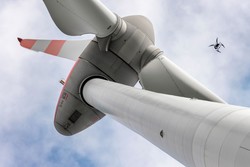News Release from Deutsche Windtechnik Ltd.
Wind Industry Profile of
Independently confirmed for the first time
Bremen (renewablepress) - The multi-stage drone system developed by the Deutsche Windtechnik Inspection Body for inspecting rotor blades and lightning protection systems has successfully passed validation. This is the conclusion reached by TÜV NORD during a conformity assessment that it carried out for the first time. The drone is able to determine the technical condition of the rotor blades and the functionality of the lightning protection system, and the risks regarding stability and public safety can then be assessed. This means that the drone system, which is called CU-RE, is also suitable for periodic inspections.
"The validation by TÜV NORD confirms that the drone technology used by the Deutsche Windtechnik Inspection Body is suitable for carrying out a range of important inspections such as periodic and condition-oriented inspections. In view of the current shortage of skilled workers and the rapidly growing turbine inventory, this is very good news for the entire industry because drones will significantly reduce the amount of work required as well as downtimes. In Germany this will close an important gap because legislators have not yet adopted any mandatory requirements for the use of drones in the wind energy industry,“ said Matthias Brandt, Director of Deutsche Windtechnik. In addition, using drones to carry out inspections provides long-term benefits associated with continuous data analysis: Over the years, monitoring the surface condition of the inspected components provides a detailed basis for predictive maintenance.
First independent validation for a German inspection body's drone system
Michael Lange, Head of the ISO 17029 Conformity Assessment Body for Wind Energy at TÜV NORD, explained: "The inspection procedure was validated against our new TÜV NORD standard. This standard defines criteria and inspection points that allow drone inspection procedures to be evaluated. For the validation, the reliability of the processes was evaluated using documentation tests. In addition to specifications for the equipment used, this also includes specifications for flying and quality assurance. The successful validation only applies to the drone technology used by Deutsche Windtechnik. Other drone systems on the market can also be evaluated using the new standard. By introducing our new standard TN-P-V01-001, TÜV NORD has responded to the increasing use of drones and created a uniform assessment for the safety of wind turbines."
Risk analysis decides whether validated drone system CU-RE is deployed
As part of an order-specific risk analysis that is carried out at an early stage, the inspection body evaluates and decides whether the drone system or rope access technology is better suited for the inspection objective. If using drone technology is found to be more suitable, the now fully validated three-stage model, which is called CU-RE (for "Close-Up and Review"), is then used in the next step. This is based on the stringent, proven inspection requirements specified by the EASA (European Union Aviation Safety Agency), which are used in the aviation industry. The first stage of the CU-RE system involves carrying out a general visual inspection using an automated drone flight. It scans 100 percent of the outer surface of a rotor blade to detect visible damage, faults or irregularities. If necessary, the first stage can be supplemented in the second stage using selective, manually guided drone technology. If more intensive inspection is required, additional specialised drone or rope access technology options can be deployed during the third stage. "Our experts decide whether a further inspection stage is necessary in order to be able to clearly identify any detected irregularities," Aeneas Noordanus, Sales Manager for inspection services at Deutsche Windtechnik, said regarding the procedure. "Increasing the level of detail of the inspection in each stage ensures that both the economic efficiency and the risks are taken into account. In the end, the now validated CU-RE drone system used by the Deutsche Windtechnik Inspection Body correctly identifies all damage to the rotor blade, allowing its influence on the stability to be assessed.“
About the Deutsche Windtechnik Inspection Body
The Deutsche Windtechnik Inspection Body, which is accredited in accordance with DIN EN ISO/IEC 17020:2012, carries out numerous technical inspections over the entire life cycle of wind turbines. These include commissioning inspections, warranty inspections, periodic inspections and condition-oriented inspections. In addition, the experts carry out assessments for continued operation, drive train monitoring and other consulting services. The worldwide accreditation of their professional and organisational competence means that the resulting expert opinions are recognised equally by all parties, including regulatory authorities, insurance companies, manufacturers and other third parties.
- Source:
- Deutsche Windtechnik AG
- Author:
- Karola Kletzsch - Communications Manager
- Email:
- K.Kletzsch@deutsche-windtechnik.com

